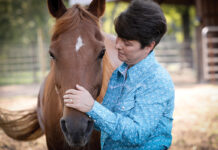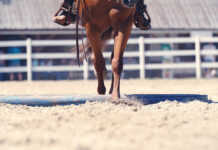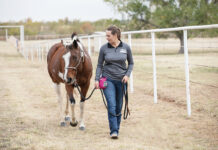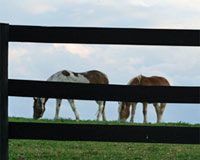
You like to think your horse has it good. He lives in a comfy stall with soft bedding, safely out of the elements. There are plenty of other horses in the barn, and your horse is turned out with some of them part of the day. He’s well-fed and groomed, and has regular hoof, dental and veterinary care. You ride him several times a week, and even when you don’t have time to ride, you at least stop by to see him.
Fight or Flight
Horses are “flight” animals, meaning when it comes to a frightening, potentially dangerous or stressful situation, their immediate response is to flee the scene. When a horse in the wild perceives a threat, he runs away. He will only stand and fight if he feels he has no other choice.
When a horse encounters a fight or flight situation, his body instinctively plunges into a state of efficiency to prepare him for immediate action: The body goes into metabolic overdrive, energy stores are mobilized, digestive processes halt and nutrients are dumped into the bloodstream. In such situations, the stress only lasts a matter of minutes. The equine body and mind were never designed to endure this reaction over a long period of time.
If the horse goes into fight or flight mode constantly because of stress—whether physical, mental or a combination of both—his body and mind eventually pay a steep price. Research has shown that long-term stress interferes with normal bone growth, contributes to obesity and insulin resistance (a major cause of chronic laminitis), and negatively affects the horse’s immunity, making it harder for him to fight off and recover from disease.
Chronic stress even affects the horse on the cellular level, and thus his overall health. “When the stress hormone cortisol enters a cell, it binds to specialized proteins called receptors, and together, cortisol and the receptors alter the activity of certain genes within the cell,” says Bruce Nock, Ph.D., a neuroendocrinologist at Washington University School of Medicine in St. Louis, Mo., who received his doctorate from the Institute of Animal Behavior at Rutgers University. “Cortisol affects a huge number of bodily processes this way.
“For example, the hoof wall grows throughout the horse’s life, but when cortisol enters an epidermal cell, it turns off the process of keratinization (the growth process that makes the hoof hard) and the integrity of the hoof is compromised,” continues Nock. “The body is very prudent when the fight or flight reaction is activated; it doesn’t waste energy on long-term projects like growing hoof.”
Stabling Considerations
Horses are meant to roam in large, open areas, and their survival instinct relies on having room to run from anything potentially dangerous or frightening. This means that putting them in a confined space where they have limited vision is, in their minds, a threat to survival.
“Putting a horse in a stall is a source of stress, but it’s the reality for many horses,” says Tom Croce of Thomas L. Croce Architects Inc. in Lebanon, Ohio. Croce has been designing equine facilities for nearly 15 years, but in the last seven years he has focused his efforts on design and stabling methods that reduce stress for horses.
“Not only is the stall a small area where a horse can’t see far, but in many cases it also doesn’t allow him to see neighboring horses, and this puts his survival instincts into overdrive,” says Croce. “Isolation deprives the horse of the protection afforded by the herd and plays into his fears of being vulnerable to predators. When a horse has a more open area and is able to see and smell other horses, he has less psychological stress.”
“Boredom and loss of control over movement and activity as a result of confinement in stalls and paddocks are powerful sources of psychological stress,” adds Nock. “It goes against some of the most basic instincts of a species that is designed physically and mentally to travel up to 20 miles a day and survive by running.”
“There are [aids] such as cribbing collars, but if a horse is cribbing, weaving, pawing or digging (stereotypical vices that are signs of psychological suffering), it’s best to deal with these problems by addressing the root causes, not just the symptoms,” says Croce. “If the facility design and management practices meet the horse’s needs while minimizing stress, you can see improvements in his health and attitude.”
Making Changes
As a conscientious owner, you can make smart choices for your horse’s well-being. By learning what causes stress for the horse, you can start eliminating them from your barn and management routine.
For starters, look at the barn itself. Are the stalls dark and closed-in with solid doors? Is there a loft or low ceiling directly over the stalls? Are the walls solid to keep horses from seeing their neighbors? All of these design elements can greatly increase the horse’s stress level.
Open and airy stalls with steel-mesh stall fronts and doors provide a sense of openness for the horse. Grillwork or bars between stalls allow horses to see and smell each other. Windows or doors opening to the outside increase light and air flow.
If you have solid or Dutch doors, swap them out for open steel-mesh doors. Better yet, replace solid stall fronts with grill or mesh fronts. At the very least, replace the stall door with a door or stall guard that allows your horse to put his head out and look around. If walls between stalls are solid, consider removing a few boards and replacing them with bars or grillwork so horses can see each other.
Adding skylights to a barn can dramatically increase daytime light without using electricity. Some older barns have a low ceiling or a hay loft over the stalls. Not only is this a fire hazard, but it also negatively impacts air quality.
“Physical stress, such as poor air quality, can affect health over time,” says Croce. “If you combine less-than-ideal air quality with social stress [from lack of contact with other horses], the horse is less able to cope with the poor air quality, and this starts a downward spiral.”
Croce says a common problem in barns is that there’s no way for rising warm air to escape the structure. This can be greatly improved by adding cupolas, louvers, or vents along the roof ridge. You can also incorporate agricultural or industrial ceiling fans to help improve air quality by mixing fresh air with the air that’s already in the barn. Look for high-volume, low-velocity ceiling fans with blades designed to move air efficiently.
Also, consider the stall’s comfort and cleanliness. It should have a level base with proper drainage and absorbent bedding that is regularly picked out and replenished. If you can smell ammonia when you walk into the barn, the odor is even stronger for your horse.
Management Practices
Even the best-built barn with airy, well-lit stalls and great ventilation can prove stressful if management practices aren’t tailored for the horses’ best interests.
When designing a barn, Croce always asks owners about the type of horses they have and their management routine. He frequently designs barns to make feeding and turnout more convenient. “If there are multiple feed rooms in a large barn and horses are fed in sections, then all the horses in that section of the barn can be fed at the same time,” he says. “That way, the last horse to be fed isn’t kicking down the barn waiting impatiently, and there’s less stress when feeding.”
Another simple management practice that can have a great impact is to stable horses that are turned out together in neighboring stalls so they can always see each other. “This way, you’re maintaining the herd, even when they’re stalled,” Croce adds.
If you board your horse, you might not have total control over management practices, but there are key things you can do to make the arrangement as stress-free as possible for him.
“Look for a barn with open, bright stalls where your horse can see other horses,” says Nock. “They should offer individual turnout, or turn horses out in compatible groups. There should be no limits on when you can visit your horse.”
If your horse is stalled much of the day, he should have access to hay to maintain digestive health and alleviate boredom. “Horses are meant to be busy grazing about 18 hours a day,” says Nock.
If you want to keep your horse at home, you should have at least two horses, as horses are naturally meant to be part of a herd.
“Companionship with a similar species is imperative for horses,” says Nock. “We can’t provide the same psychological support that another equine can offer. It’s not good for a horse to be alone under any circumstances.”
Nock suggests that a Miniature Horse or donkey can be a perfect companion for a single horse if you don’t want two full-sized equines.
Enrich the Environment
As an owner, your horse’s well-being is your responsibility. The goal should be to provide an enriched environment and lifestyle that keeps things pleasant and interesting for your horse. Some people think that means adding toys to their horse’s stall, but Nock explains that it goes beyond that.
“An enriched environment is just one that provides sensory, motor, cognitive and social stimulation,” he says. “Exercise is one of the most commonly used methods of environmental enrichment in scientific studies. Get the horse out of the stall, take him for walks, go trail riding, or take him in the trailer to a new place to ride. Vary your routine a little to make it interesting for him.”
The bottom line is that stress in the domestic horse is based on multiple factors. “You can’t just say putting a horse in a stall is stressful and leaving him outside is not,” says Nock. “It’s more complicated than that. It has to be based on the entire management picture. Some of the unnatural stressors that go along with life in captivity are more or less unavoidable. The best we can do is to minimize the severity of the stress as much as possible and protect the horse against its impact.”
Further Reading
Stress Less
Turnout Time
The Stresses of Easy Living
Cynthia McFarland is an Ocala, Florida-based freelance writer and horse owner. The author of eight books, her latest is Cow-Horse Confidence: A Time-Honored Approach to Stockmanship, co-authored with Martin Black.
This article originally appeared in the September 2011 issue of Horse Illustrated. Click here to subscribe.






Very informative
Great article – Our barn is designed so that horses can see each other between stalls – we have used chain link fencing from the top of the stall wall to the ceiling between each stall. This allows the horses, when stabled to see each other plus allows good air flow.
I agree 100% with your article! I’ve had horses on my property for over 25 years, and no one was ever kept just in a stall. Each horse had a stall, along with a 30’run which included a 12′ overhang in their run so they could all eat outside and see each other. The stalls each had bars between them, so even when they were in their stalls, they didn’t feel alone. I had mesh screens on their front stall doors too. Each run had access to the arena and grass, and if they all got along, they could hang out together. Putting a horse in a stall only is like keeping a human in a bathroom! I know it gets hard when you are boarding your horse, as before I got my own horse property, that’s all I had for my horse too and it drove me crazy. Horses need stimulation from other horses, from the ability to walk around, to be in the sun or go into the shade, to munch on a little hay and just be a horse. Check out my website to see what I’m talking about. http://www.bitoheavenfarm.com God gave us animals to take care of and enjoy. It is a priviledge and I enjoy it so much! As with any animal that we have in our care, it is our job to treat them with dignity and love. They count on us to do the right thing. We are their everything! “In His hands is the life of every creature and the breath of all mankind.” Job 10:12
Interesting! I hope that everyone has a great and safe weekend!
Unless, a horse is started being in a stall as a baby, they have a hard time adjusting to be confined. They will walk back and forth, trying to find a way out. Horse are born to be free. Only my babies or young horses stay in a stall, and that is only to eat grain, and be warm and dry at night.
my babies are allowed to roam on 11 acres with a run in barn they don’t like being locked in a barn
cool
It’s always best to have horses out in the field if possible. My horses would not like being in a stall at all!
And this is why I have mine out in the pasture 24/7. The more natural it is, the better horses do.
l